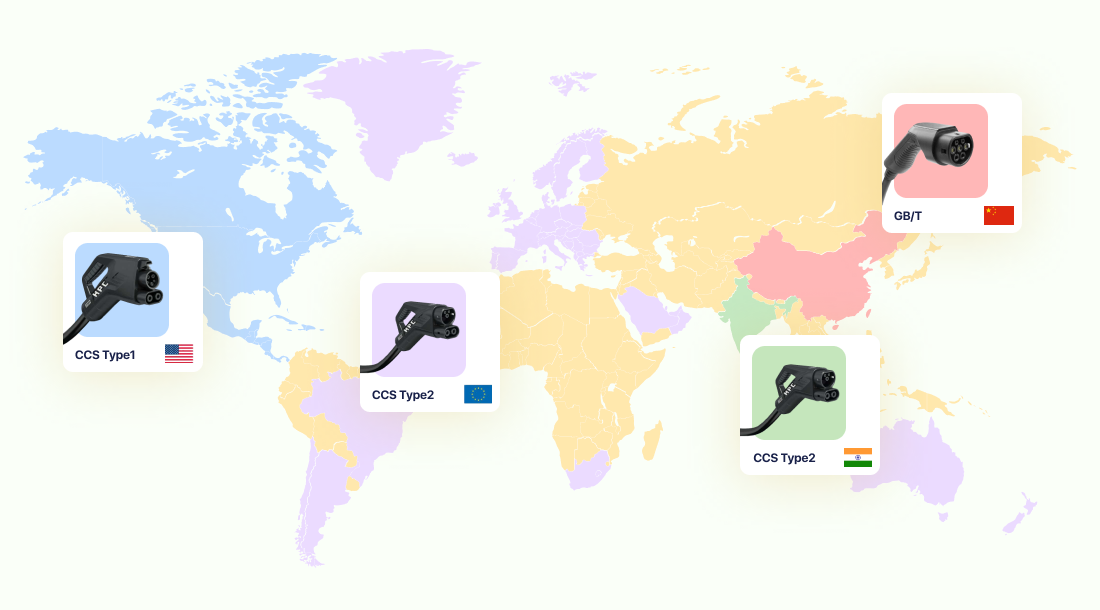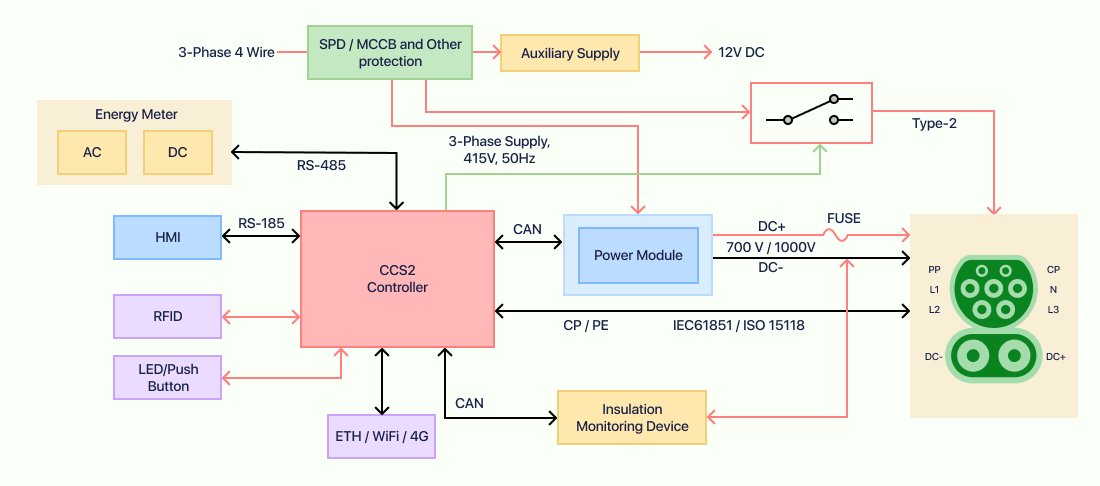| Model | AC | DC |
|---|---|---|
| Hyundai Kona | CCS2 | CCS2 |
| Tesla Model 3 (EU) | CCS2 | CCS2 |
| Tata Tigor & NEXON | CCS2 | CCS2 |
| Nissan’s Leaf | Type 1/2 | CHAdeMO |
| Tesla China Model | Type 2 | GB/T |
Quick Summary:
Did you know that 6.4 million EVs were already sold worldwide during the first half of 2021, with an estimated 16 Million unit sales comprising two-thirds of the total vehicle sales by the year-end?
The approaching electric cars in India are gearing up with matured powertrains operating on high voltages. Tata Motors along with Tata Power have come together to install 30-50 KW CCS2 standard charging stations to build a sustainable ecosystem for future electric vehicles.
In this blog post, I will get you through how India can acclimatize to the Combined Charging System for EV by employing accurate CCS2 controllers as its standard for building level-3 DC chargers. Let us begin!
Table of Contents
Introduction
Unlike the IC engine vehicles with a standard inlet for their fuel tanks, the Electric Vehicle segment is still adapting to the distinct charging infrastructures present in different regions. These standards have been proposed and adopted, considering the governing bodies, consumer requirements, and behavior patterns.
Consider this; if you are an EV owner, your EV will be equipped with two charging modes.
An AC charging with on-board control and DC (fast charging) at a charging station.
Both the chargers have different plug designs as per utility and suitability.
As per the Bharat EV Specifications, both AC and DC have subcategories of charging. Let us quickly go through them.
1. AC Charging
- Normal Charging: With the assistance of onboard chargers, the normal AC 2.5KW to 3 KW can charge a four-wheeler and heavy vehicle within 5-6 hours.
- Fast Charging: These are high-power rated on-board chargers enabling charging at a quicker rate from 7.5 KW to 22 KW
2. DC Charging
- Level 1 Charging (Home): A 40-mile trip can easily be accomplished by charging overnight with a level 1 charger. It uses a standard 120 V plug, drawing a maximum current of 200 ‘A’ at an output voltage between 48V to 72V. Power output is achieved at a range from 10 kW to15 kW.
- Level 2 Charging: There is separate charging equipment for these chargers, which must be purchased and installed. Level 2 chargers can replenish a 40-mile trip within 2 hours. Drawing an output voltage up to 1000V delivering power outputs between 30 to 150 kW
- DC Fast Charging: DC Fast charging can only be achieved at Public charging stations. Charging per minute delivers a range of 10 to 20 miles.
Basically, there are four main DC fast charging connectors.
1. If you are charging a Tesla car, you will require a Supercharger
2. BMW, VW, GM cars are powered by a CCS (SAE Combined Charging System)
3. CHAdeMO is used by companies like Nissan and Mitsubishi
4. Chinese auto companies use GB/T – BYD as their standard
Are you looking for a CCS Controller with all the necessary built-in features ready to support your EV charging infrastructure?
Check out Bacancy’s CCS2CON and future-proof your EV charging ecosystem today.
Global EV Charging Standards

OEMs like Hyundai, Nissan, Tesla, and Porsche have prioritized country-wise governing standards and preferences of the users before providing separate or combined AC and DC ports.
Let us understand how
The image below will help you visualize how most regions have standardized two charge ports for AC and DC charging.

Country-wise Charging Standards
With multiple charging ports spread across the globe, the capital, time & effort required to set up the EV charging infrastructure is constantly rising. EV manufacturers are bound to invest in coping up with different standards.
For instance, Tesla China Model 3 offers two ports to keep up with the government-regulated GB/T standard and the Type-2 standard for charging at home.
On the other hand, for Indian variants, OEMs like Tata and Mahindra have been complying with Bharat EV Charger AC-001 & DC-001 specifications.
Tata Tigor XPRES-T and Mahindra e Verito electric sedan have GB/T DC connectors for EV charging.
It is vital to know that as per the revised policy on ‘Charging Infrastructure for Electric Vehicles – Guidelines and Standards,’ the Ministry of India has declared that for every 100 km, there will be at least one Fast Charging Infrastructure preferably with the Public Charging Stations.
The policy implies that the infrastructure for DC fast charging will ramp up, and so is the need to commonize a sustainable charging standard.
TATA Tigor, NEXON, Hyundai Kona, MG eZS, and Audi e-tron have adopted the Combined Charging System for EV in gearing up with the fast-charging technology.
What Is a Combined Charging System for EV?
Also referred to as combo, the CCS charging network is a common ground for AC & DC charging. These are obtained from AC Type 1 & Type 2 connectors added with two extra pins at the bottom for DC charging. The connectors are called Combo 1 and Combo 2, respectively.
This open, standardized system is used globally. Audi, BMW, Chrysler, Daimler, Ford, GM Porsche, and Volkswagen adhere to this charging system for propelling high transmission power trains which operate on high voltages.

Design of a CCS2 plug
You can see how a CCS2 port looks like. The top section has five pins and is utilized for a Type 2 connector in AC charging, delivering power upto 22kWh.The bottom section is for the fast charging DC which can optimally give a power output upto 350kWh (depending on vehicle specifications)
Bacancy is serving the E-mobility industry with future-ready EV solutions.
Get in touch with the Leading Product Engineering Services Company
CCS v/s CHAdeMO
CCS employs Homeplug Green PHY, a PLC specification that uses the same cables for carrying AC and DC current. Whereas CHAdeMO operates on CAN bus protocol for communication between the charger and EV. Additional cables are used in CHAdeMO to facilitate communication & AC charging.
Both of them are fast DC chargers; still, the majority of the OEMs prefer CCS over CHAdeMO because of multifaceted communication support and its availability. Some of the other functionalities of CCS include Home Network Integration, Payment, and Billing.
CHAdeMO chargers are backed by the Japanese EV market, while the CCS chargers are widely accepted by the US and EU (European Union)
Do you know that Tesla, for its EVs in the CHAdeMO accepted nations, sells an external adapter too?
Bacancy’s CCS2 controller (CCS2CON)
Bacancy’s CCS2 Controller (CCS2CON) is the supreme communication interface between your Electric Vehicle (EV) and Electric Vehicle Supply Equipment (EVSE) for DC fast charging. It manages all the charging processes, especially for the DC fast charger in sync with DIN 70121 and ISO-15118 (PnC).
Supporting the built-in features, the CCS2CON integrates the DC Charging components such as Power Module, Insulation Monitoring Device, RFID-based authentication, and an HMI User Interface. This results in an overall flawless experience while developing a DC fast-charging system.
How It Works

Block Diagram of CCS2CON (Bacancy’s CCS2 Controller)
The CCS2CON communicates with your EV, monitoring the control parameters and during charging such as current flow and displays the ongoing processes and runtime status on the HMI panel. It is powered by 4G, Ethernet, and Wi-Fi for connectivity, making it feasible for remote maintenance.
Features of Bacancy’s CCS2CON
- Compliant with ISO/IEC 15118 and DIN 70121
- Sustains Dual CCS2 Interface in parallel
- Supports Single Type-2 Interface
- RFID for Vehicle authentication
- HMI Interface to display charging data over Modbus
- Supports OCPP1.6J with an extendable OCPP2.0.1 configuration
- Suitable for 30kW,60kW,120kW Chargers

Final Words
To summarize the whole discussion, it is evident that adopting a particular standard will be a sustainable solution for the automotive industry. The Combined Charging System for EV is no doubt omnipresent across the globe since it is the most reliable and promising solution for both consumers & manufacturers. And so will be the need for having precise communication models equipped with standard protocols, typically the OCPP.
Bacancy’s extended venture Bacancy Systems is a leading embedded company renowned for its Product Engineering Services. Bacancy’s CCS2 control (CCS2CON) is the most technically innovative solution for building level 3 chargers, with a robust and lean model in adapting to the rapidly transforming EV charging ecosystem.
Your Success Is Guaranteed !
We accelerate the release of digital product and guaranteed their success
We Use Slack, Jira & GitHub for Accurate Deployment and Effective Communication.



